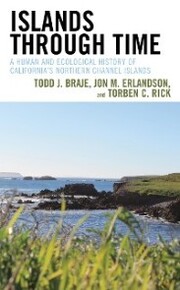Detailansicht
Islands through Time
eBook - A Human and Ecological History of California's Northern Channel Islands
ISBN/EAN: 9781442278585
Umbreit-Nr.: 3010026
Sprache:
Englisch
Umfang: 200 S.
Format in cm:
Einband:
Keine Angabe
Erschienen am 06.11.2021
Auflage: 1/2021
E-Book
Format: PDF
DRM: Adobe DRM
- Zusatztext
- <p><span>Explore the remarkable history of one of the jewels of the US National Park system</span></p><p><span></span></p><p><span>Californias Northern Channel Islands, sometimes called the American Galápagos and one of the jewels of the US National Park system, are a located between 20 and 44 km off the southern California mainland coast. Celebrated as a trip back in time where tourists can capture glimpses of California prior to modern development, the islands are often portrayed as frozen moments in history where ecosystems developed in virtual isolation for tens of thousands of years. This could not, however, be further from the truth.</span></p><p></p><p><span>For at least 13,000 years, the Chumash and their ancestors occupied the Northern Channel Islands, leaving behind an archaeological record that is one of the longest and best preserved in the Americas. From ephemeral hunting and gathering camps to densely populated coastal villages and Euro-American and Chinese historical sites, archaeologists have studied the Channel Island environments and material culture records for over 100 years. They have pieced together a fascinating story of initial settlement by mobile hunter-gatherers to the development of one of the worlds most complex hunter-gatherer societies ever recorded, followed by the devastating effects of European contact and settlement. Likely arriving by boat along a kelp highway, Paleocoastal migrants found not four offshore islands, but a single super island,</span><span>Santarosae</span><span>. For millennia, the Chumash and their predecessors survived dramatic changes to their land- and seascapes, climatic fluctuations, and ever-evolving social and cultural systems.</span></p><p><span></span></p><p><span>Islands Through Time</span><span>is the remarkable story of the human and ecological history of Californias Northern Channel Islands. We weave the tale of how the Chumash and their ancestors shaped and were shaped by their island homes. Their story is one of adaptation to shifting land- and seascapes, growing populations, fluctuating subsistence resources, and the innovation of new technologies, subsistence strategies, and socio-political systems.</span><span>Islands Through Time</span><span>demonstrates that to truly understand and preserve the Channel Islands National Park today, archaeology and deep history are critically important. The lessons of history can act as a guide for building sustainable strategies into the future. The resilience of the Chumash and Channel Island ecosystems provides a story of hope for a world increasingly threatened by climate change, declining biodiversity, and geopolitical instability.</span></p>
- Kurztext
- <p><span>Islands Through Time </span><span>tells the remarkable story of the human and ecological history of California¿s Northern Channel Islands. The resilience of the Chumash and Channel Island ecosystems provides a story of hope for a world increasingly threatened by climate change, declining biodiversity, and geopolitical instability.</span></p> <p></p> <p></p>
- Autorenportrait
- <p><span>Todd J. Braje</span><span>, associate professor of anthropology at San Diego State University, has spent nearly 15 years exploring the archaeology, ecology, and history of the Northern Channel Islands. He has been editor of the Journal of California and Great Basin Anthropology, currently serves as coeditor of the Journal of Island and Coastal Archaeology, and is author of</span><span>Modern Oceans, Ancient Sites</span><span> (2010) and</span><span>Shellfish for the Celestial Kingdom</span><span> (2016).<br></span><span>Jon Erlandson</span><span> is director of the Museum of Natural and Cultural History and professor of anthropology at the University of Oregon. He has published 20 books and hundreds of scholarly articles, many drawing on his nearly 40 years of work on the Channel Islands. In 2013, Erlandson was elected a fellow of the American Academy of Arts and Sciences.<br></span><span>Torben Rick</span><span> is curator of human environmental interactions and chair of the department of anthropology at the Smithsonians National Museum of Natural History. He has active field projects on Californias Channel Islands and the Chesapeake Bay, which are collaborative with researchers from a variety of disciplines and focus on ancient and modern human environmental interactions.</span></p>
